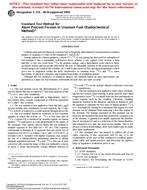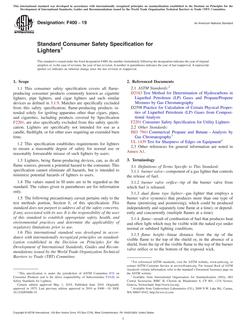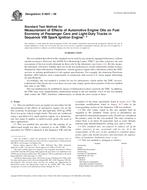1.1 This test method covers the determination of the steady-state thermal transmission properties of flat-slab specimens of thermal insulation using a thin heater of uniform power density having low lateral heat flow. A thin heater with low lateral thermal conductance can reduce unwanted lateral heat flow and avoid the need for active-edge guarding.
1.2 This primary test method of thermal-transmission measurement describes a principle, rather than a particular apparatus. The principle involves determination of the thermal flux across a specimen of known thickness and the temperatures of the hot and cold faces of the specimen.
1.3 Considerable latitude is given to the designer of the apparatus in this test method; since a variety of designs is possible, a procedure for qualifying an apparatus is given in .
1.4 The specimens must meet the following conditions if thermal resistance or thermal conductance of the specimen is to be determined by this test method:
1.4.1 The portion of the specimen over the isothermal area of the heater must accurately represent the whole specimen.
1.4.2 The remainder of the specimen should not distort the heat flow in that part of the specimen defined in .
1.4.3 The specimen shall be thermally homogeneous such that the thermal conductivity is not a function of the position within the sample, but rather may be a function of direction, time, and temperature. The specimen shall be free of holes, of high-density volumes, and of thermal bridges between the test surfaces or the specimen edges.
1.4.4 Test Method C 177 describes tests that can help ascertain whether conditions of are satisfied. For the purposes of this test method, differences in the measurements of less than 2 % may be considered insignificant, and the requirements fulfilled.
1.5 The specimens shall meet one of the following requirements, in addition to those of .
1.5.1 If homogeneous materials as defined in Terminology C 168 are tested, then the thermal resistivity and thermal conductivity can be determined by this test method.
1.5.2 If materials which are layered or otherwise thermally inhomogeneous are tested, thermal resistance and thermal conductance can be determined by this test method.
1.6 Two versions of thin-heater apparatus using the same principle of the standard are described in and . They are similar in concept but differ in size and construction, and hence warrant separate descriptions for each design. This test method in no way limits the size of the thin-heater element. One of the units described uses a thin metal foil, while the other uses a metal screen as the heat source. The smaller, foil apparatus is designed to make rapid measurements of heat transmission through specimens as thin as 0.5 cm and as thick as 2 cm; however, an apparatus using a foil heater could be designed to measure much thicker materials, if desired. The larger, screen apparatus is designed to measure specimens with thicknesses between 3 and 15 cm, where the exact limits depend on the thermal resistance of the specimens. Both apparatuses use thermocouples for measuring temperature, but other temperature-sensing systems can be used.
1.7 This test method covers the theory and principles of the measurement technique. It does not provide details of construction other than those required to illustrate two devices which meet the prescribed requirements. Detailed information is available in References
This standard does not purport to address all of the safety concerns, if any, associated with its use. It is the responsibility of the user of this standard to establish appropriate safety and health practices and determine the applicability of regulatory limitations prior to use.
Product Details
- Published:
- 03/01/2006
- Number of Pages:
- 10
- File Size:
- 1 file , 240 KB


